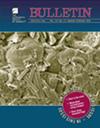苏鲁造山带大陆俯冲带两个克拉通的板块断裂闪长斑岩
IF 3.9
1区 地球科学
Q1 GEOSCIENCES, MULTIDISCIPLINARY
引用次数: 0
摘要
同碰撞岩浆作用在大陆地壳生长和成熟过程中起着重要但未被充分认识的作用。然而,关于大陆俯冲带同碰撞中间岩浆的起源仍有争议,一些模型认为它们是由弧相关过程形成的,而另一些模型认为它们是由后来的板块断裂引起的熔融形成的。古特提斯苏鲁超高压(UHP)大陆碰撞造山带中侵入花岗质片麻岩的闪长斑岩岩脉继承了206Pb/238U年龄约为749 ~ 238 Ma的锆石颗粒和加权平均年龄为216 ~ 215 Ma的岩浆锆石,这些锆石的年龄在苏鲁超高压岩石从超高压峰值条件到角闪岩相的挖掘过程中有很好的限定时间范围(约235 ~ 208 Ma);因此它们是共碰撞的。岩脉中Cr (330 ~ 402ppm)、Ni (84.5 ~ 103ppm)和Mg#(64 ~ 66)值较高,显示地幔成因。斑岩具有较高的Sm/Yb、Nb/Y、La/Yb和Gd/Yb比值,是典型的板块断裂岩浆活动特征。结合岩浆锆石的弧形微量元素模式和富集的Sr-Nd同位素组成、年龄和εHf(t)值(- 19.5 ~ - 17.0)及其构造背景,我们提出了一种同碰撞板块断裂模型,该模型认为,在古特提斯洋闭合后的晚三叠世碰撞中,附属于扬子克拉通的大洋板块在华北克拉通下方分离时形成的缺口中,软流圈上升流最初产生了熔融体。闪长斑岩岩脉与附近石岛辉长-正长-花岗岩杂岩具有一致的Sr-Nd同位素组成和时空关系,其构造亲和性存在争议。因此,我们认为闪长斑岩和石岛杂岩来源于两个克拉通,其中包括华北克拉通富集的次大陆岩石圈地幔,它们与扬子陆-洋过渡边缘俯冲地壳分离的下沉板块产生的丰富的长英质熔体相互作用。该研究揭示了碰撞造山带地壳再循环与大陆生长的新关系,并表明大陆俯冲带的板块断裂可产生相当数量的同碰撞中间岩浆,代表了与弧岩浆不同且更演化的大陆生长的混合补充,其组成与大块大陆地壳相似。本文章由计算机程序翻译,如有差异,请以英文原文为准。
Slab breakoff diorite porphyries derived from two cratons in a continental subduction zone, Sulu orogen, China
Syncollisional magmatism plays an important but underappreciated role in continental crust growth and maturation. However, the origin of syncollisional intermediate magmas in continental subduction zones is controversial, with some models suggesting they form by arc-related processes, and others indicating they form by later slab breakoff−induced melting. Diorite porphyry dikes intruding granitic gneiss in the Paleo-Tethyan Sulu ultrahigh-pressure (UHP) continental collisional orogen have inherited zircon grains with 206Pb/238U ages of ca. 749−238 Ma, and magmatic zircons with weighted mean ages of 216−215 Ma, falling within the well-constrained time range (ca. 235−208 Ma) tracking exhumation of the Sulu UHP rocks from UHP peak conditions to amphibolite facies; they are thus syncollisional. The dikes have high Cr (330−402 ppm), Ni (84.5−103 ppm), and Mg# (64−66) values, showing a mantle origin. The porphyries have relatively high Sm/Yb, Nb/Y, La/Yb, and Gd/Yb ratios, representing a classic signature of slab breakoff magmatism. Together with the arc-like trace-element patterns and enriched Sr-Nd isotope compositions, ages, and εHf(t) values (−19.5 to −17.0) of magmatic zircons and their tectonic setting, we propose a syncollisional slab breakoff model in which the melts were initially generated from asthenospheric upwelling in the gap created when the oceanic slab attached to the Yangtze craton detached underneath the North China craton during Late Triassic collision following Paleo-Tethys Ocean closure. The diorite porphyry dikes have consistent Sr-Nd isotope compositions and spatiotemporal relationships with the nearby Shidao gabbro-syenite-granite complex, for which the tectonic affinity is controversial. Thus, we argue that the diorite porphyries and Shidao complex were sourced from two cratons, including the enriched subcontinental lithospheric mantle of the North China craton, which interacted with abundant felsic melts derived from the sinking slab breaking away from the subducted crust of the Yangtze continental-ocean transitional margin. This study sheds new light on crustal recycling versus continental growth in collisional orogens and implies that considerable syncollisional intermediate magmas can be generated by slab breakoff in continental subduction zones, representing hybrid additions to continental growth that are different and more evolved than arc magmas and have a composition similar to that of the bulk continental crust.
求助全文
通过发布文献求助,成功后即可免费获取论文全文。
去求助
来源期刊

Geological Society of America Bulletin
地学-地球科学综合
CiteScore
9.30
自引率
8.20%
发文量
159
审稿时长
4-8 weeks
期刊介绍:
The GSA Bulletin is the Society''s premier scholarly journal, published continuously since 1890. Its first editor was William John (WJ) McGee, who was responsible for establishing much of its original style and format. Fully refereed, each bimonthly issue includes 16-20 papers focusing on the most definitive, timely, and classic-style research in all earth-science disciplines. The Bulletin welcomes most contributions that are data-rich, mature studies of broad interest (i.e., of interest to more than one sub-discipline of earth science) and of lasting, archival quality. These include (but are not limited to) studies related to tectonics, structural geology, geochemistry, geophysics, hydrogeology, marine geology, paleoclimatology, planetary geology, quaternary geology/geomorphology, sedimentary geology, stratigraphy, and volcanology. The journal is committed to further developing both the scope of its content and its international profile so that it publishes the most current earth science research that will be of wide interest to geoscientists.
 求助内容:
求助内容: 应助结果提醒方式:
应助结果提醒方式:


